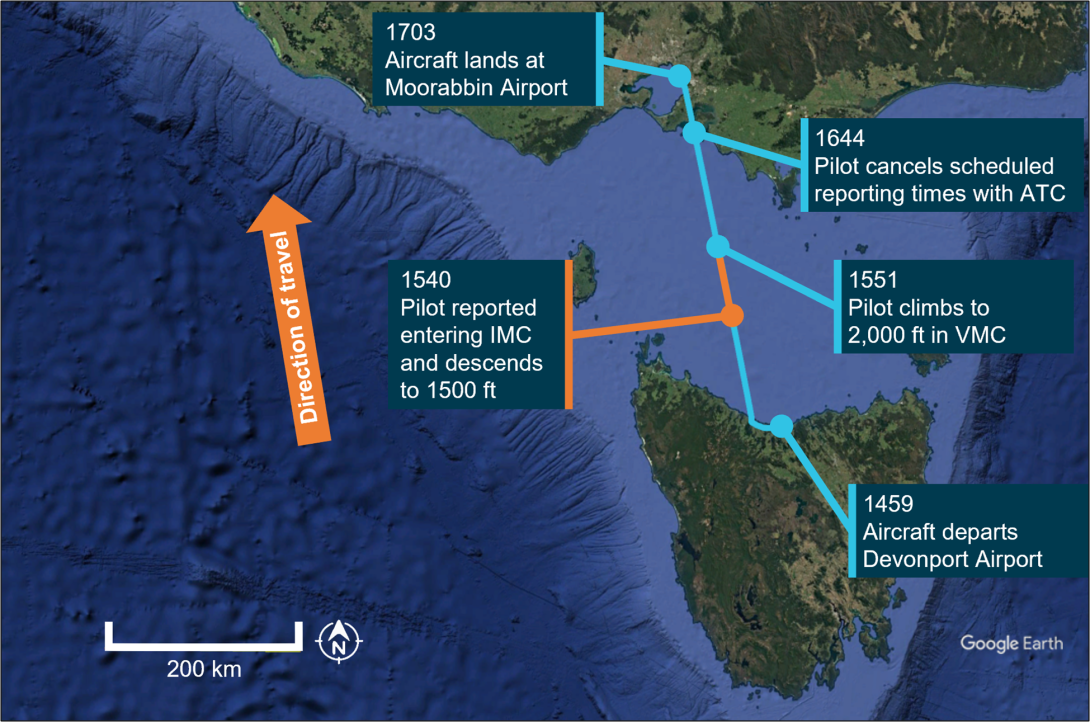What happened
On 6 June 2025, the pilot of a Cirrus SR20 aircraft was conducting a private flight between Devonport Airport, Tasmania, and Moorabbin Airport, Victoria, under visual flight rules (VFR)[1] with the pilot and one passenger on board. The pilot held a private pilot licence (aeroplane).
Prior to the departure, the pilot stated that they reviewed the weather briefings accessed through an electronic flight bag application and obtained directly from the Bureau of Meteorology. After a discussion with their flight instructor, the pilot determined that forecast conditions were suitable to proceed with the flight across the Bass Strait under VFR to Moorabbin.
They also stated they made an informed decision to depart ‘as soon as possible’ due to forecast strong gusts in the vicinity of Moorabbin Airport and the end of evening civil twilight,[2] which occurred at 1736 local time.
After departing Devonport at 1459, the aircraft initially proceeded on a westerly heading to conduct a brief ‘scenic’ leg (Figure 1). The pilot then made a right turn in a northerly direction toward Moorabbin Airport and climbed to 4,500 ft above mean sea level, cruising below scattered[3] cloud observed at about 5,000 ft in the vicinity of the coastline to the west of Devonport Airport.
Figure 1: Aircraft flight path and key events

Source: Google Earth, annotated by the ATSB
At about 1530, they recalled a lowering of the cloud base accompanied with a reduction in forward visibility. The pilot descended to about 2,000 ft to remain clear of cloud and immediately advised ATC of the deteriorating weather conditions and that they anticipated entering instrument meteorological conditions[4] (IMC) imminently.
At 1540, the pilot subsequently recalled entering IMC but reported being able to see below the aircraft. They immediately advised ATC and descended to 1,500 ft, at which point they regained visual meteorological conditions[5] (VMC). At 1551, confident of remaining clear of cloud, the pilot climbed back to 2,000 ft and continued the flight to Moorabbin in VMC.
The pilot recalled the autopilot was utilised throughout the flight and that scheduled reporting times were implemented at 15‑minute intervals with ATC until 1644 when they were cancelled by the pilot. The aircraft landed at Moorabbin Airport at 1703.
Safety message
Pilots operating under visual flight rules are encouraged to make conservative decisions when considering how forecast weather may affect their flight. Establishing a ‘personal minima’ is recommended for pilots to provide additional operational margins which account for factors such as weather, experience and recency.
One of the key risk controls for a visual flight rules pilot to avoid entering instrument meteorological conditions is appropriate pre‑flight preparation and planning. Pilots should always obtain up‑to‑date weather information before and during flight. While forecasts will assist in selecting the route to be flown, pilots should plan an alternate or be prepared to make necessary deviations from the planned route should actual weather conditions indicate the possibility of not being able to comply with the VFR.
For a non-instrument rated pilot, even with basic attitude instrument flying proficiency, maintaining control of an aircraft in IMC by reference to the primary flight instruments alone entails a very high workload that can result in narrowing of attention and loss of situational awareness. If entering cloud becomes unavoidable, the use of an autopilot by a suitably trained pilot can assist with maintaining the desired flight path and remove inadvertent inputs. While autopilot can be used to reduce workload, it is not infallible and should not be relied upon or used by VFR pilots as a risk mitigator to decide to fly into unsuitable conditions.
Additionally, ATC services such as Flight Following,[6] can assist the pilot with managing workload and improving situational awareness. Subject to ATC workload, information derived from Bureau of Meteorology weather radar sites can also be provided to pilots.
ATSB booklet Accidents involving Visual Flight Rules pilots in Instrument Meteorological Conditions (AR-2011-050, revised 2019) provides for guidance on avoiding VFR into adverse weather. Further resources for preventing VFR into IMC can also be found on the Civil Aviation Safety Authority’s website.
About this report
Decisions regarding whether to conduct an investigation, and the scope of an investigation, are based on many factors, including the level of safety benefit likely to be obtained from an investigation. For this occurrence, no investigation has been conducted and the ATSB did not verify the accuracy of the information. A brief description has been written using information supplied in the notification and any follow-up information in order to produce a short summary report, and allow for greater industry awareness of potential safety issues and possible safety actions.
[1] Visual flight rules (VFR): a set of regulations that permit a pilot to operate an aircraft only in weather conditions generally clear enough to allow the pilot to see where the aircraft is going.
[2] Scattered cloud is a meteorological term used in aviation to describe cloud coverage that occupies 3 to 4 oktas (eighths) of the sky.
[3] Evening civil twilight begins at sunset and ends when the geometric centre of the sun is 6 degrees below the horizon.
[4] Instrument meteorological conditions (IMC): weather conditions that require pilots to fly primarily by reference to instruments, and therefore under instrument flight rules, rather than by outside visual reference. Typically, this means flying in cloud or limited visibility.
[5] Visual Meteorological Conditions (VMC): weather conditions expressed in terms of flight visibility and the horizontal and vertical distance from cloud for the application of VMC criteria in various airspace classifications.
[6] Flight Following: the provision of ongoing surveillance information service which is an on request service provided to assist pilots of VFR flight within ATS surveillance system coverage in Class E and Class G Airspace, to avoid other aircraft or to assist in navigation.


